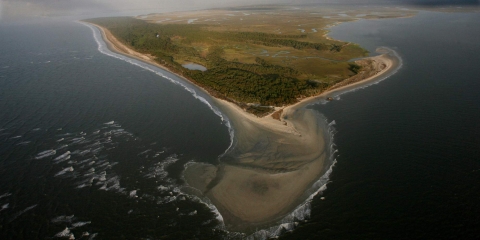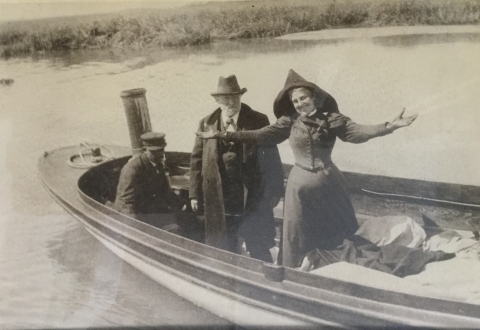About Us
Wassaw, one of Georgia's coastal barrier islands, was designated a National Wildlife Refuge on October 20, 1969. Unlike many of Georgia's Golden Isles, little development and few management practices have modified Wassaw's primitive character. The 10,053-acre refuge includes beaches with rolling dunes, live oak and slash pine woodlands, and vast salt marshes.
Our Mission
Wassaw NWR, as part of the Savannah Coastal Refuges Complex, will protect a unique network of bottomland hardwood forests, wetlands, grasslands, beaches, and aquatic habitats. In the midst of a rapidly developing coastal environment, the refuge will lead the way in protection and management of highly diverse habitats. The refuge will contribute to the long-term conservation of migratory and native wildlife populations, and the recovery of endangered and threatened species.
When compatible, the refuge will offer quality, wildlife-dependent recreational activities. In collaboration with partners, a wide range of interpretive and environmental education programs and activities will be provided to diverse audiences. Visitors will leave with an understanding that this place of incredible diversity and ecological importance is part of a larger network of protected lands within the National Wildlife Refuge System, set aside specifically for wildlife.
Each unit of the National Wildlife Refuge System is established to serve a statutory purpose that targets the conservation of native species dependent on its lands and waters. All activities on those acres are reviewed for compatibility with this statutory purpose. The purpose(s) of this unit is. . . “for use as a bird refuge and as an experiment station for acclimatization of certain foreign game birds” (Executive Order 4512, September 20, 1926); and, “for use as an inviolate sanctuary, or for any other management purpose for migratory birds” (16 U.S.C. 715d, Migratory Bird Conservation Act).
Our History
Indigenous Peoples
The discovery of artifacts dating to A.D. 500-600 reveal the presence of indigenous peoples who apparently used the island for hunting and fishing. The name “Wassaw” comes from the Creek word for sassafras, “wiso”, which grows on the island.
Earliest Ownership
Wassaw’s recorded history began in the early 1800s with Anthony Odingsell, a free black planter and fisherman who inherited Little Wassaw Island from his former owner. In an attempt to escape a cholera epidemic in 1846, 300 enslaved Africans/African Americans, likely including 11 owned by Odingsell, were sent to Wassaw. Despite this effort, most, if not all, died anyway and according to records, were buried there, although the locations of the burial sites remain unknown.
During the Civil War, the island was occupied first by Confederate and then by Union troops. Blowing sand once revealed the unmarked grave of a soldier, along with a 56-caliber bullet and a uniform button of the First Georgia Regiment. Cannonballs were found the full length of the northern end of the island, indicating heavy shelling, possibly by Union troops.
The Parsons Family Legacy
In 1866, Wassaw, Little Wassaw, and the surrounding salt marshes were purchased by George Parsons, a wealthy businessman from Maine, as a gift for his wife. He constructed nearly 20 miles of road and built a housing compound in the center of the island for family and friends.
Battery Morgan
During the Spanish-American War (1898), Parsons permitted the construction of a gun battery on Wassaw’s north end that would serve to protect the southern approach to the city of Savannah from Spanish attack. The battery was later named after Lieutenant Henry Sims Morgan who planned and supervised its construction and died a hero several months later attempting to rescue sailors stranded on a grounded ship during a hurricane.
Refuge Establishment
In an effort to preserve the island in its natural state, the Parsons family and others formed the Wassaw Island Trust in 1930. Later concerned that the State of Georgia might condemn the island and open it for development or public use, the Trust negotiated a transfer to the federal government, facilitated by The Nature Conservancy. In 1969, Wassaw National Wildlife Refuge was established with stipulations that the islands would be preserved in their natural state, that no bridge would ever be built connecting the refuge to the mainland, and that the Wassaw Island Trust would retain a 180-acre inholding, including the housing compound, for use by its members.
Other Facilities in this Complex
A National Wildlife Refuge Complex is an administrative grouping of two or more refuges, wildlife management areas or other refuge conservation areas that are primarily managed from a central office location. Refuges are grouped into a complex structure structure
Something temporarily or permanently constructed, built, or placed; and constructed of natural or manufactured parts including, but not limited to, a building, shed, cabin, porch, bridge, walkway, stair steps, sign, landing, platform, dock, rack, fence, telecommunication device, antennae, fish cleaning table, satellite dish/mount, or well head.
Learn more about structure because they occur in a similar ecological region, such as a watershed or specific habitat type, and have a related purpose and management needs. Typically, a project leader or complex manager oversees the general management of all refuges within the complex and refuge managers are responsible for operations at specific refuges. Supporting staff, composed of administrative, law enforcement, refuge manager, biological, fire, visitor services, and maintenance professionals, are centrally located and support all refuges within the complex.
The refuges within the Savannah Coastal Refuges Complex span a 100-mile stretch of coastline and total nearly 60,000 acres. The Complex headquarters is located within the Savannah National Wildlife Refuge Visitor Center at 694 Beech Hill Lane, Hardeeville, South Carolina, 29927.




